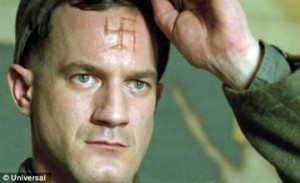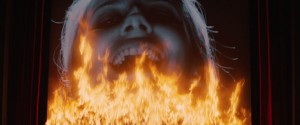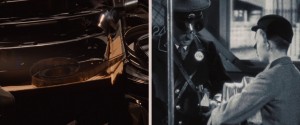Inglourious Basterds is Quentin Tarantino’s alternative to one of America’s more comfortable historical narratives. World War II’s morally simplistic narrative of good versus evil is relatively uncontested. Especially in the European sphere, a continent away from the nasty questions of atomic weapons and internment camps, the West celebrates American heroism and its conquering of Nazi evil. When George Bush wanted to label his enemies, the conquered alliance of WWII offered a name: the Axis of Evil, which wasn’t the descendent of the Axis Powers historically but was forced into that narrative rhetorically. The war’s memory might not be fresh among living Americans, but it still offers a shortcut for accessing feelings of American victory over evil. What should we make, then, of Tarantino’s new ending to the war?
Critic Jonathan Rosenbaum, formerly of the Chicago Reader, offers a critical takedown of the movie’s new ending: “Inglourious Basterds makes the Holocaust harder, not easier to grasp as a historical reality,” (italics his). That is, by ignoring some of the horrors of reality, Basterds’ fantasy encourages historical amnesia. However, this seems challenging to reconcile with the opening scene’s portrayal of the coldblooded murder of Jews to the delight of an SS officer. An officer who responds to being called the Jew Hunter with relish, for he “love[s] the title.” The movie contains depictions of the day-to-day horror of the bureaucratic work that supported the Holocaust, and takes the time to capture Shoshanna’s fear in response to it. Her gulps of air, after Hans Landa stops questioning her, sound like she has been choked by fear. Ignoring the Holocaust would be problematic, but Basterds doesn’t deny its existence, or even its horror. Additionally, this probably isn’t the right line of inquiry. Rosenbaum-and critics like him- seem occupied with representation of history. But with Tarantino’s construction of a new history, the larger concern should be with the implications of the new ending. What does it show about the stories we want to be true, as compared to the ones that are?
One path to an answer is through the movie’s recasting of the victors, specifically how the alternate conquerors defy Nazi categories of racial purity. The US army fighting on the European front was ethnically diverse; black Americans discriminated against at home fought for the country at war. But Basterds replaces an ethnically mixed group of soldiers with a group of Jews, led by a Native American man. Lt. Aldo Raine “got a little Indian in,” him, and the script suggests his noticeable but never mentioned neck scar comes from a noose. While Raine looks white (he’s played by Brad Pitt!), his backstory grants him the mantle of the racially impure. The other Basterds backstories are easier; they are Jews fighting the Third Reich, two from Austria and Germany, the rest from the States. This shift in history offers the chance for the World War II Jew to be more than a victim. Not only do they escape a pitying victimhood, but the movie invests time and energy into the creation of what Christian Thorne calls the “image of the tough-guy Jew,” so it can celebrate Jews pumping Hitler full of lead, castrating a Nazi via bullets, or lunging in slow-motion to kill Hitler’s bodyguard. But the movie’s character creation doesn’t stop there. The other revenge plot features two conspirators: a Jewish woman and her black lover. She escapes the Nazis before plotting their death. While she does not represent the same vein of Jewish machismo as the Basterds, Shoshanna still offers Jewish resistance. Fredrick Zoller, the Nazi sniper and boy wonder, chases after the Frenchwoman’s love, and expresses an entitlement to her body during the fateful scene in the projection room. The Nazis view her as inferior for her identities as both a woman and a Jew. Her black lover’s inferiority gets taken as fact by Goebbels, who won’t even let Marcel perform his job as projectionist because of his race. Contrast their success with the film’s two white heroes, Bridget von Hammersmark and Archie Hicox, who die before they can come close to defeating the Nazis. The movie’s resistance comes from the very people the Nazis made a national project of oppressing.
The alternate history’s alternate heroes offer a direct repudiation of Nazi ideology. America’s victory clearly indicated that racially integrated troops could defeat the Aryan army. But the Allies real-life win is complicated by America’s ugly racial past, a point made clear by an SS officer’s pointed jab at “the history of the Negro in America.” Where the US can’t be a perfect hero, the victims of Nazi violence can be. The new world constructed by this alternate fiction places power in the hands of those the Nazis hate, and allows them to defeat their enemies. Basterds’s victory shows us what a world looks like where Nazi ideology doesn’t just lose, but loses to those it hates the most.
Tarantino’s alternate history offers a new path to salvation through ethnic and religious minorities, but also via culture. The conflagration in the theater positions the “movie as WMD, destroying the Third Reich, ending the war,” Ben Walters claims, which is “an alluring idea, indeed, but a flagrantly fantastical one.” (20) A combination of homemade and classic culture destroys both propaganda and Nazis as the whole. Old reels offer the kindling to destroy Nazi culture and society. Two amateurs film offer a narration of the destruction. Movie culture saturates Basterds; Operation Kino is German for cine, as in cinema; Hicox and Hammersmark are a critic and a star respectively; German directors of the period get namedropped; Aldo Raine comes from Aldo Ray; and so on, the movie’s accoutrements forming a veritable mountain of referential winks and nods. The movie indicates a desire to care about movies, and to show that it cares. Movies matter, Tarantino says, and says, and says. The climax comes from movies offering a response to propaganda, with the antidote to poisonous culture coming from its genuinely good variants. The better ending to World War II comes with a cultural solution. Good movies save us from the bad.
This reading of the movie sees it as genuinely transformative. For two and a half hours, the path to a new-and-improved world gets put on display. In this world, the victimized strike back decisively against their oppressors, and movies aid in their fight. But Tarantino doesn’t make this an easy escape to a better world. What critics describe as a fantasy is more complicated than escapism. There are two problems with it. The first comes from the realm of the Basterds.
The Basterds’ obsession with marking their enemies doesn’t indicate a desire to create a new world, but to solidify the hierarchy of the old. The second-to-last shot of the movie is Aldo’s knife carving a swastika into Landa’s forehead, with blood gushing, the victim screaming, and the camera lingering on the butchered skin. Then, the camera flips perspective to a smiling Aldo and Utivich, admiring their “masterpiece.” The stated rationale is that, post-war, Landa will remove his uniform and become anonymous, just another rich man on Nantucket. The scars keep the recognition of Landa’s evil. Preserving the moral hierarchy of the past seems unnecessary-after the real war, Nazis get sent to jail, and even a colonel with immunity likely wouldn’t escape notice as a German who fought on behalf of the Nazis. Beyond redundancy, the markers indicate a desire for a moral hierarchy for the future derived from the status quo. Rather than offer a solution to the conflicts of the old world, the new creation apparently should maintain the old’s battles. Not only is Raine’s practice cruel and bloody, but it passes up transcendence for preservation.

The Basterds’ scars
The second issue with Inglourious Basterds as a solution comes from Tarantino’s treatment of film. The movies-as-savior narrative doesn’t align with the film’s actual stance. Rather, Tarantino forces both film and its creators to die a fiery death. Zoller and Shoshanna die; Marcel and Goebbels die; Nation’s Pride and the unnamed revenge flick both burn. Shoshanna responds to Zoller’s film question “Who has a message for Germany?” by saying she does, for she is the “face of Jewish vengeance.” Then everything bursts into flames. Jewish vengeance answers Nazi patriotism, and the consequence is it all dies. At best, vibrant movie culture serves as a rejoinder to overzealous propaganda. At worst, it cancels it out. Either way, movie culture fails to offer enduring salvation.

Face of Jewish vengeance? Sure. Film representation of a path to utopia? Less clear
Even in Tarantino’s references to movie history, movies create tragedy. One of the weirdest little injections of outside culture comes from the scene where nitrate film’s explosiveness gets explained to the moviegoer. A split screen effect allows for the left side to pan over spools of film while the right contains a clip from Alfred Hitchcock’s 1936 film Sabotage. After the part excerpted for Inglourious Basterds, the boy shown with nitrate film from the sample makes it onto a bus. The package under his arm turns out to be a bomb, which explodes, and the nitrate film amplifies the explosion. The innocent boy dies. Movies can’t be relied on to defend us; we shouldn’t even rely on them to avoid killing us.

Sabotage (1936) on the right, as inserted by Tarantino
Even as Tarantino “both salutes and problematizes the power of film,” as Walters describ es it, he draws comparisons between the actions of the Nazis and their Allied counterparts. (22) Thorne shows this through in a series of paired images; the carving of the swastika in the forehead and Nation’s Hero carving a swastika into wood; Eli Roth and Zoller taking the same angle down the barrel of their guns; the Apache comments from Aldo Raine and the drunken German. Look at the only two times the camera zooms in on a cigarette. First, Hans Landa stabs it into a delectable strudel, ruining the dessert. Next, it rotates in slow-motion after Marcel’s throw before lighting the pile of film. The seemingly unnecessary shot of strudel protruding from cigarette can’t pass without an equally extraneous shot of a cigarette preparing to hit the nitrate. Walters describes a parallel between Landa and Tarantino’s pacing. “The multilingual, dialogue-heavy longueurs that precede each chapter’s concluding ecstasy of violence map onto Landa’s taking his time with his victims, stringing out the small talk, having another glass of milk, not eating the strudel before the cream arrives,” with both the director and the SS officer relishing that suspense. (22) That parallel phrasing produces the uncomfortable comparison of the audience, of us, to the victims. The power of film certainly is “problematized,” for it ties together all-too-tightly the fascists and their opponents.
But then the film reaches off-screen to make sure its critique hits home, too. Both Walters and Thorne point out the callous laughter of Hitler as echoing the cackles within the theater during the exact same show. “Only a thoughtless viewer will not see him or herself reflected in shots of Hitler cackling,” Walters proclaims, with the implication that there are lots of thoughtless viewers. (22) The audience can’t be inoculated from viral ill-will just because it’s separated by a screen. Watching the movie and celebrating its deaths makes you resemble Hitler, which would merely be like the baser elements of internet name calling if Tarantino didn’t lodge this critique through an elaborate visual schema of similarities.
Looking at the film’s alternate history seems misguided as an exercise in finding political messages. Though it creates a new history, that history is subsumed to a larger message. The movie takes on the Third Reich not to prove a point about resistance to fascism, though it comments on it along the way. Rather, the moral logic of Nazism, and our abhorrence for its associations, lulls an audience into cheering for the reversal of Nazi evil as justice. Rosenbaum’s concern- “Basterds makes the Holocaust harder, not easier to grasp as a historical reality,”- gets it perfectly wrong. Basterds makes it possible to grasp the Holocaust as a modern possibility.
Works Cited
Rosenbaum, Jonathan. “Some Afterthoughts about Tarantino.” Blog post. 27 Aug. 2009. Web. 17 Nov. 2016. <www.jonathanrosenbaum.net/2009/08/16606/>.
Thorne, Christian. “Tarantino, Nazis and Movies That Can Kill You-Part 1.” Blog post. Commonplace Book. Williams College, 9 June 2011. Web. 17 Nov. 2016. <http://sites.williams.edu/cthorne/articles/tarantino-nazis-and-movies-that-can-kill-you-part-1/>.
Thorne, Christian. “Tarantino, Nazis and Movies That Can Kill You-Part 2.” Blog post. Commonplace Book. Williams College, 17 June 2011. Web. 17 Nov. 2016. <http://sites.williams.edu/cthorne/articles/tarantino-nazis-and-movies-that-can-kill-you-part-2/>.
Walters, Ben. “Debating Inglourious Basterds.” Film Quarterly, vol. 63, no. 2, 2009, pp. 19–22. www.jstor.org/stable/10.1525/fq.2009.63.2.19.